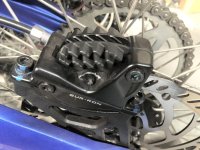ElectricGod
10 MW
fechter said:ElectricGod said:These Kenda tires are truly awful...lol...like we didn't already know that!
Boy, you can say that again! Those Schwalbes look like a great alternative for a stock A2B, which I still have a couple of. The really bad feature on the Kenda tires was that sharp edge on the side of the tread. If you lean into a corner hard enough to get on that edge, it just washes out and you crash. That and they get flats just by looking at them wrong.
LOL...I was already skeptical they were NOT any good well before people started saying they were no good. I too saw that edge on the tire tread and thought there was no way it would hold decent grip in a hard turn. The way the tire wall rolls over was disconcerting too. They didn't exactly design these bikes to be fast or powerful and the factory tire is pretty much meant for slow and easy riding. The Schwalbe bike tires might be a mistake...don't know yet how well they will do under power and speed. What I can say for sure is they are lots better than the factory tires.
This A2B won't be stock by any means! It will run a 5kw outrunner (Revolt RV-100-Pro) mid-drive at 16S or 20S. Which battery voltage is still TBD.
16S = 45 mph, 20S = 55 mph...ish...on this motor. 20S will be a heavier and bigger battery so that may keep me at 16S.
I have purchased hydraulic brakes, 203mm rotors and brake adapters. Say goodbye to the mechanical brakes!
I know there are better hydraulic bike brakes out there, but they also cost an arm and both kidneys! Lots of people use this brake on mountain bikes and they do fine. They ought to do OK for me too. Worst case, buy better ones later if they fade too fast. $50...probably still better than the mechanical brakes they will replace.
https://www.amazon.com/gp/product/B0751GN9VZ/ref=ox_sc_act_title_1?smid=A3652ZBQ53FUEE&psc=1
Magura makes a variety of brake adapters so I got a QM9 for the back and a QM5 for the front so both wheels can have 203mm rotors.
I'm not super concerned about weight and these are cheap. I looked at a variety of videos where people did 203mm upgrades and these specific rotors came up quite a lot as working well. At $22 a set...I can live with that.
https://www.amazon.com/gp/product/B073M8WF2Q/ref=ox_sc_act_title_3?smid=A2KJYE1N4P74F3&psc=1
Not as important...purely asthetic...the back wheel now has black spoke nipples. I HAD to make the front wheel match. I have pulled apart the front wheel and will be adding spoke washers under each nipple and using black ones instead. The bearings in the front wheel are smooth and turn nicely. No point in replacing them.


















